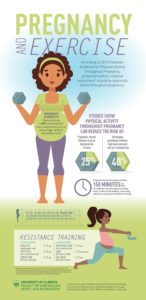Gone are the days when pregnancy meant that you needed to put your feet up and avoid exercise. In fact, research suggests that exercise has many benefits:
- Maintains and improves maternal fitness
- Prevents excessive weight gain
- Psychological benefits including reduced symptoms of depression
- Growing evidence that exercise can prevent and help manage gestational diabetes and pre-eclampsia
- Associated with shorter and less complicated labour, fewer neonatal complications
Encouragingly, there is no evidence to suggest that regular exercise during an uncomplicated pregnancy is problematic for the mother or baby.
Guidelines from obstetric experts around the world now encourage aerobic exercise of moderate intensity for 150 minutes per week as well as twice-weekly resistance exercise.
There are however some precautions and contraindications to observe so it is important to discuss your exercise plans early in your pregnancy with your obstetric provider. These precautions relate to such things as pre-existing health conditions, placenta position, unexplained bleeding etc.
When exercising there are some safety precautions to observe as well as indicators to cease exercise.
Safety precautions for prenatal physical activity |
|
Reasons to stop physical activity and consult a healthcare provider |
|
Exercise for specific areas during pregnancy.
- Abdominals – you may have heard and be concerned about “abdominal separation” or diastasis rectus abdominus. This refers to the stretching and widening of the connective tissue between the 2 bellies of the rectus abdominus muscle to accommodate the growing baby. Research suggests that this happens in up to 100% of women during pregnancy. There is some evidence that exercise (general or specific abdominal exercises) may reduce the extent of separation after delivery. Our Women’s Health Physiotherapist Louise Henderson can advise on the appropriate exercises for you. If you observe “doming” with particular exercises you should cease that exercise and consult Louise for alternatives.

Picture of “doming” (From www.belliesinc.com)
Pelvic floor – regular pelvic floor exercises during pregnancy is associated with a significant reduction in urine leakage (50% reduction during pregnancy and 35% reduction postnatally). International guidelines recommend instruction in proper pelvic floor muscle technique by a health professional trained in this area such as Louise.
– aside from their role in the prevention of urine leakage, the pelvic floor muscles can be associated with pain in the pelvic girdle (pubic symphysis and sacro-iliac joints). Counterintuitively, rather than the muscles being weak, it is more often that they are working too hard and need to be taught to relax.
- Learning to contract and relax the pelvic floor muscles can help with preparation for a vaginal delivery.
- Mythbuster – doing pelvic floor exercises during pregnancy does NOT mean you will be more likely to experience a significant perineal tear during a vaginal delivery.
BENJAMIN, D. R., VAN DE WATER, A. T. M. & PEIRIS, C. L. 2014. Effects of exercise on diastasis of the rectus abdominis muscle in the antenatal and postnatal periods: a systematic review. Physiotherapy, 100, 1-8.
MOTTOLA, M. F., DAVENPORT, M. H., RUCHAT, S.-M., DAVIES, G. A., POITRAS, V. J., GRAY, C. E., GARCIA, A. J., BARROWMAN, N., ADAMO, K. B. & DUGGAN, M. 2018. 2019 Canadian guideline for physical activity throughout pregnancy. Br J Sports Med, 52, 1339-1346.
SALVATORE, S., RADEMAKERS, K., DELANCEY, J., IGAWA, Y., KOELBL, H., LATERZA, R. M., SERATI, M., SULTAN, A., SIEVERT, K. D. & LOWRY, A. 2017. Pathophysiology of urinary incontinence, faecal incontinence and pelvic organ prolapse. Incontinence: 6th International Consultation on Incontinence. Tokyo.


